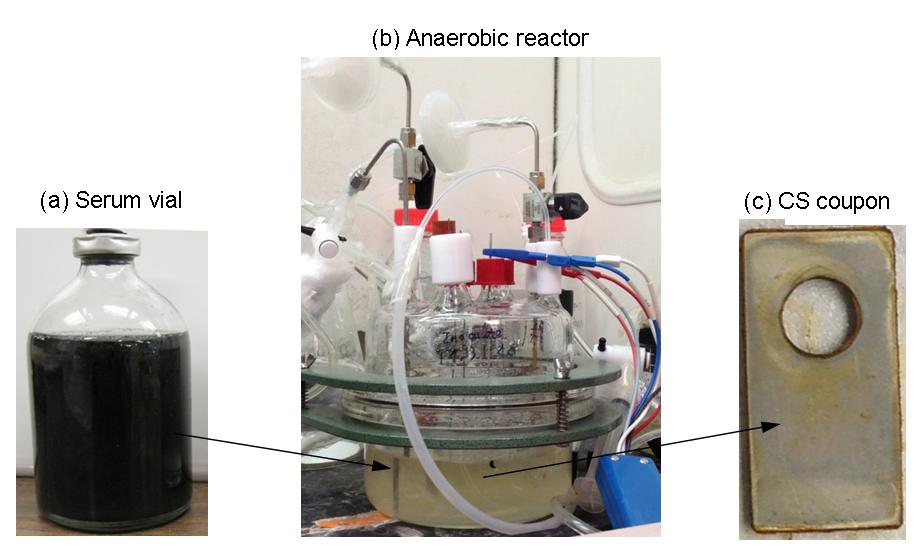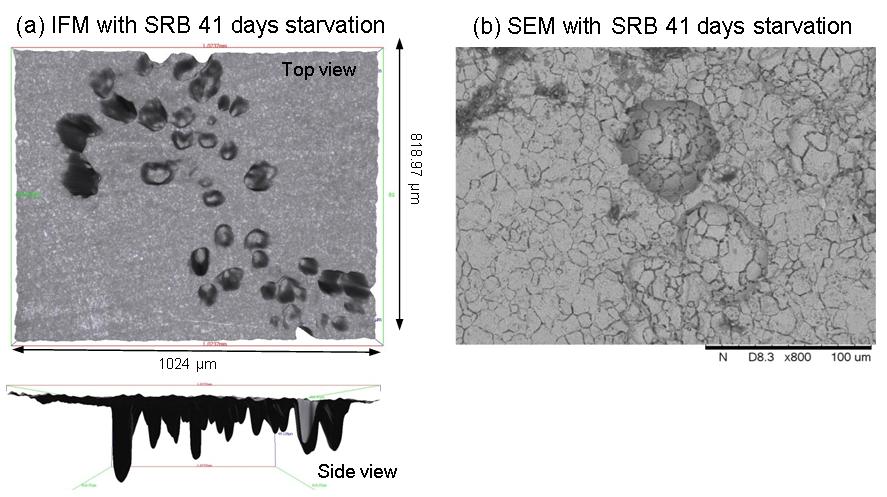Our MIC group studies focus on sulfate reducing bacteria (SRB) induced corrosion on carbon steel (CS) and stainless steel (SS). The following areas are covered in our study:
(1) Mechanism for SRB-induced corrosion on CS or SS
(2) Method development for fast characterization of pitting corrosion
(3) Development of MIC mitigation approaches
Microbiologically influenced corrosion (MIC) is corrosion affected by the presence and metabolism of microorganisms. MIC has received much attention because of the increasing recognition of costs associated with corrosion damage on water storage tanks, water mist firefighting systems, pipelines, and potable water systems. According to a recent Federal Highway Agency (FHWA) report, corrosion damages cost the United States $276 billion in 1998, and MIC was related to half of the total cost of corrosion damage.
Sulfate reducing bacteria (SRB) are generally considered one of the most troublesome groups of bacteria that cause MIC, especially of steel. Although MIC has attracted attention, it is still very difficult to identify and mitigate due to the complicated phenomena associated with MIC. In addition, critical knowledge of the complex interactions among microbial communities and their effects on metal corrosion is still missing.
We have designed various sterile systems under strictly anaerobic condition (Figure 1) to study biofilm-metal interactions. We discovered that SRB was capable of inducing severe pitting corrosion (Figure 2 (a)) even after long term organics-starvation [1]. Intergranular corrosion has also been observed (Figure 2 (b)).
Our MIC project is collaborating with Dr. Bi-min Zhang Newby. Visit Dr. Newby’s website for more information on their microbial research
 |
| Figure 1 Experimental setup of (a) serum vial for culturing SRB, (b) anaerobic reactor for MIC studies and (c) CS coupons that were submerged in the reactor. |
 |
| Figure 2 (a) IFM and (b) SEM images of the polished side of CS coupons that had been exposed to D. vulgaris culture for 43 days. |
Acknowledgements:
This work was supported by a grant from the U. S. Department of Defense Office of Corrosion Policy and Oversight and the research sponsor, the US Air Force Academy.
Journal Publications:
[1] Y. Chen, Q. Tang, J. M. Senko, G. Cheng, B. Zhang Newby, H. Castaneda, L.-K. Ju, “Long-term survival of Desulfovibrio vulgaris on carbon steel and associated pitting corrosion”, Corrosion Science (2014), in press.
[2] Y. Chen, R. Howdyshell, S. Howdyshell, and L.-K. Ju, “Characterizing pitting corrosion caused by a long-term starving sulfate-reducing bacterium surviving on carbon steel and effects of surface roughness”, Corrosion (2014), 70(8), 767-80.
[3] M Sodagari, H Wang, L-K Ju, “Effects of rhamnolipids on initial attachment of bacteria on glass and octadecyltrichlorosilane-modified glass”, Colloids and Surfaces B: Biointerfaces, 2013, 103: 121-8.
Conferences Papers and Presentations:
[1] Y. Chen, B.-m. Zhang Newby, G. Cheng, H. Castaneda, J. Senko, L.-K. Ju. “Distribution of sulfate-reducing bacteria around the pits on carbon steel”, Corrosion 2014, San Antonio, TX, Mar. 2014.
[2]L.-K. Ju, B.-m. Zhang Newby, G. Cheng, J. Senko, H. Castaneda-Lopez, Y. Chen, H. Wang, “Can Microorganism Induce and/or Influence Corrosion?”, TCC-review meeting, Columbus, OH, August, 2013.
[3] Y. Chen, X. He, R. Howdyshell, S. Howdyshell, B.-m. Zhang Newby, G. Cheng, H. Castaneda, J. Senko, and L.-K. Ju, “Severe pitting corrosion caused by a starving sulfate-reducing bacterium surviving on carbon steel and effect of surface roughness”, Corrosion 2013, Paper No. 2568, Orlando, FL, Mar. 2013.
[4] Y. Chen, Q. Tang, S. Howdyshell, R. Howdyshell, B.-m. Zhang Newby, G. Cheng, H. Castaneda, J. Senko and L.-K. Ju, “Pitting corrosion on carbon steel caused by a starving sulfate-reducing bacterium and the biofilm morphology change”, NCERCAMP Forum, Akron, OH, Sep. 2012.
[5] Y. Chen, Q. Tang, R. Howdyshell, S. Howdyshell, B.-m. Zhang Newby, G. Cheng, H. Castaneda, J. Senko and L.-K. Ju, “Survival of a sulfate-reducing bacterium presumably on iron oxidation and the accelerated pitting of carbon steel”, DoD TCC (Annual Technical Corrosion Collaboration) meeting, Akron, OH, Jun. 2012.
[6] Y. Chen, B.-m. Zhang Newby, H. Wang, L.-K. Ju, J. Senko, “SRB Metabolism, Biofilm and Microbiologically Influenced Corrosion”, DoD TCC meeting, Hattiesburg, MS, Jan. 2012
[7] H. Wang, M. Sodagari, Y. Chen, Q. Tang, X. Shan, G. Cheng, J. Payer, L.-K. Ju, B.-m. Zhang Newby, “Developing flow systems for monitoring initial stages of biofilm formation on microbiologically induced corrosion”, Department of Defense Corrosion Conference 2011, Palm Springs, CA, August 5, 2011.
[8] Y. Chen, R. Howdyshell, H. Wang, X. He, M. Sodagari, Q. Tang, B.-m. Zhang Newby, L.-K. Ju, G. Cheng, J. Senko, “Metabolism of sulfate reducing bacteria”, DoD TCC meeting, Akron, OH, Dec. 2011
Poster Presentations:
[1] Y. Chen, S. Roth, B.-m. Zhang Newby, G. Cheng, H. Castaneda, J. Senko and L.-K. Ju, “Anaerobic corrosion on carbon steel caused by a sulfate-reducing bacterium”, DoD TCC meeting, Akron, OH, Aug. 2014.
[2] K. Invally, Y. Chen, B.-m. Zhang Newby, G. Cheng and L.-K. Ju, “Effects of rhamnolipids on bacterial attachment and microbial influenced corrosion”, DoD TCC meeting, Akron, OH, Aug. 2014.
[3] Y. Chen “Mechanism of SRB-induced corrosion on carbon steel under starvation: implications for MIC control”, Corrosion 2014, San Antonio, TX, Mar. 2014.
[4] Y. Chen and Hua Wang, “Developing flow systems for monitoring the early stage of microbiologically influenced corrosion by sulphate reducing bacteria”, 2011 DoD corrosion conference, La Quinta, CA, August 2011.